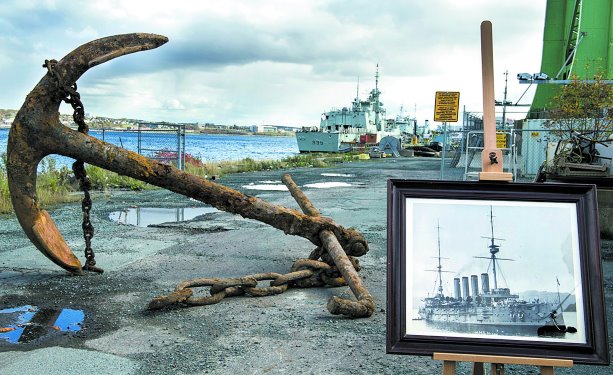Demolition crews at Her Majesty’s Canadian (HMC) Dockyard Halifax uncovered more salvage than they expected with the discovery of a 100-year-old anchor believed to have belonged to His Majesty’s Canadian Ship (HMCS) Niobe.
Originally purchased from Britain’s Royal Navy, HMCS Niobe was an 11,000-tonne armoured cruiser, the first Canadian warship to enter the country’s territorial waters on October 21, 1910. The ship was launched in 1897 and previously saw service in the Boer War.
The 900-kilogram anchor measures four metres from crown to head, and 3.35 metres across the flukes. It was found at former Jetty 4, on the site of Building D19 in HMC Dockyard on Oct. 14, coincidentally just days before the official proclamation of Niobe Day.
"The discovery of one of HMCS Niobe’s anchors in Halifax Harbour just a week before proclaiming Oct. 21 to be known and celebrated in the Royal Canadian Navy as Niobe Day is astonishing," said Vice-Admiral Mark Norman, Commander of the Royal Canadian Navy, following the discovery.
"This is a true blessing and a rare opportunity to connect the dots between our forefathers and the next generations of sailors of the Royal Canadian Navy."
The demolished building, a Second World War warehouse, was one of the first structures erected at HMC Dockyard. It was scheduled for demolition to make way for a new jetty that will accommodate a fleet of ships to be delivered through the National Shipbuilding Procurement Strategy.
"Dexter Construction won the contract to effect the demolition and remediation," says Major Adam Beaver, Engineering Officer, Base Construction Engineering, Canadian Forces Base (CFB) Halifax.
"Upon completion of the demolition of building D19, rubble was sorted by type for recycling or to be moved off site. They were breaking up the concrete slab and in the process inadvertently dug deeper than required. It was during this part of the digging that they luckily discovered the tip of the anchor—with chain links."
Each link of the chain measures 51 centimetres by 28 centimetres and weighs about 34 kilograms.
"The anchor was actually lying on an angle between the water rising toward the old building but was completely buried and the chain link actually was lying parallel to the slab, about two to three feet under the subgrade material," Beaver says.
He quickly called on the services of Richard Sanderson, Director of the Naval Museum of Halifax.
Mike Bonin, base public affairs officer at CFB Halifax, says that, once the anchor was recovered, a 15-metre crack appeared in the pavement. The crack was likely caused by tension on the chain believed to be buried under the pavement in a straight line to shore.
"As directed and supervised by the museum curator, they recovered as many chain links as they safely could," says Beaver. "The chain had to be removed very carefully as it was located below a 25-kilovolt electrical line and had to be cut off short as it likely would have pulled up the line and road with it causing major delays to the project itself."
Cutting a single chain link to free the anchor took about 45 minutes.
The Naval Museum notes that the Niobe functioned as a depot ship from 1915 until 1920, moored in Halifax Harbour. The Halifax Explosion of December 6, 1917 destroyed the ship’s upper works and pulled the ship’s concrete-embedded anchor from the harbour floor. The ship was later re-secured to Jetty 4 by three additional anchors placed on shore. The unearthed anchor is believed to be one of the three, simply covered by infill in subsequent years.
"There’s a good chance as they excavate for the new jetty, they will find the other half of the chain," says Beaver.










Recent Comments
comments for this post are closed